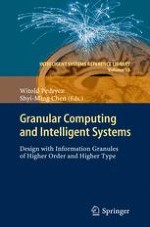Information granules are fundamental conceptual entities facilitating perception of complex phenomena and contributing to the enhancement of human centricity in intelligent systems. The formal frameworks of information granules and information granulation comprise fuzzy sets, interval analysis, probability, rough sets, and shadowed sets, to name only a few representatives. Among current developments of Granular Computing, interesting options concern information granules of higher order and of higher type. The higher order information granularity is concerned with an effective formation of information granules over the space being originally constructed by information granules of lower order. This construct is directly associated with the concept of hierarchy of systems composed of successive processing layers characterized by the increasing levels of abstraction. This idea of layered, hierarchical realization of models of complex systems has gained a significant level of visibility in fuzzy modeling with the well-established concept of hierarchical fuzzy models where one strives to achieve a sound tradeoff between accuracy and a level of detail captured by the model and its level of interpretability. Higher type information granules emerge when the information granules themselves cannot be fully characterized in a purely numerical fashion but instead it becomes convenient to exploit their realization in the form of other types of information granules such as type-2 fuzzy sets, interval-valued fuzzy sets, or probabilistic fuzzy sets. Higher order and higher type of information granules constitute the focus of the studies on Granular Computing presented in this study. The book elaborates on sound methodologies of Granular Computing, algorithmic pursuits and an array of diverse applications and case studies in environmental studies, option price forecasting, and power engineering.
